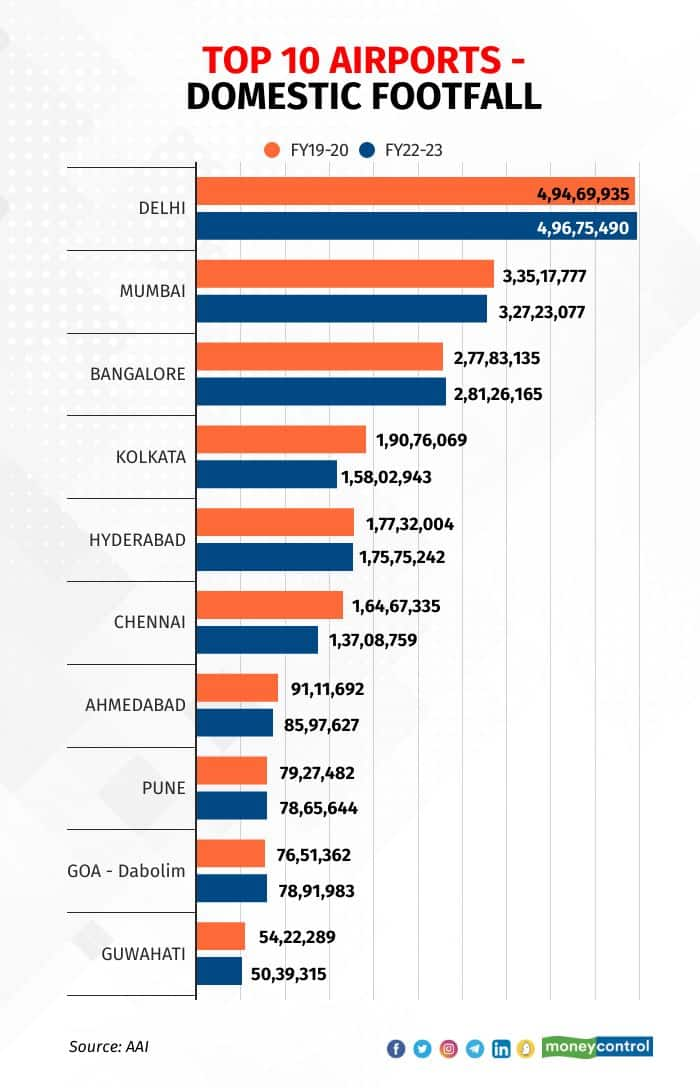



The Airports Authority of India (AAI) released the annual footfall figures for Indian airports over the weekend. The data shows there has been a clear recovery from pre-Covid times in FY22-23.
How did the top 10 airports perform?
There are some changes in the order of the top 10 airports of the country by domestic footfalls. Hyderabad has moved up to fourth spot, pushing Kolkata down by one, and Goa moved up from ninth to eight, pushing Pune down by one.
Three of the top 10 airports saw an improvement in traffic in FY22-23 compared to FY19-20. Goa’s Dabolim airport handled 3.1 percent more passengers, while Bengaluru processed 1.2 percent more passengers, and Delhi saw 0.5 percent additional passengers. Hyderabad and Pune handled more or less the same number of passengers as they did pre-pandemic.
The largest drop was at Kolkata, where footfalls fell 17.16 percent, followed by Chennai, where footfalls dropped 16.75 percent. Guwahati and Ahmedabad, now operated by Adani Airports, saw a drop of 7 percent and 5.6 percent, respectively. Mumbai, the second busiest airport in the country, saw a 2.4 percent drop in domestic footfalls.

How did airports beyond the top 10 perform?
Among the major airports, Srinagar and Chandigarh have performed the best. Srinagar saw a 57 percent growth in footfalls, while Chandigarh grew 52 percent. The numbers at Srinagar are on account of the lower base since 2019-20, when Article 370 was abrogated and tourism adversely impacted. In the case of Chandigarh, the growth is an indicator of its true potential being harnessed after the new terminal came into existence, allowing more flights and increased hours of operations.
At airports like Gorakhpur, Tirupati, Jodhpur, Dehradun, Amritsar, Leh, Pantnagar, Shillong, Mysore, and Agra, among others, the growth was driven by pilgrimages and tourist destinations, with traffic in FY22-23 exceeding that of 2019-20.
Airports that did badly
Thanks to the Regional Connectivity Scheme — UDAN (Ude Desh ka Aam Nagrik) — the count of airports has gone up substantially over the last few years. But even as newer airports have come up, the older ones have lost out on connectivity.
Pithorgarh, Ludhiana, Pathankot, Jalgaon, Bhatinda, Adampur, Salem, and Nanded lost out on connectivity post Covid. RCS-UDAN envisioned that the routes would be commercialised in the three year exclusivity period, however that has not been the case across routes and airports.
At places like Jalgaon or Salem, the only operator (TruJet) went bust leading to suspension of services, and as a result the airport became defunct.
Airports which started operations post-pandemic
From pre-Covid times till now, more airports have come on the map than fallen off it. This year saw the blockbuster opening of the Manohar International Airport at Mopa in Goa. In less than three months of operations the new airport has seen over 6 lakh footfalls.
Greenfield airports at Hollangi in Arunachal Pradesh, Sindhudurg in Maharashtra, and Deoghar in Jharkhand also started operations in the last financial year. Operations resumed at Coochbehar, Keshod, Rupsi, Jeypore, and Ziro, among others.
In sum
To an extent, the footfall at airports is an indicator of economic activity.
While there has been a slight increase in Covid cases of late, and the economy could see other headwinds as well, bookings are strong and the travel and hospitality industry is looking forward to this summer eagerly.
How the traffic pans out in the near future will decide the fate of many airlines and will also dictate the pricing that the government can attract for the next round of airport privatisation, which is expected soon.
Discover the latest Business News, Sensex, and Nifty updates. Obtain Personal Finance insights, tax queries, and expert opinions on Moneycontrol or download the Moneycontrol App to stay updated!
Find the best of Al News in one place, specially curated for you every weekend.
Stay on top of the latest tech trends and biggest startup news.